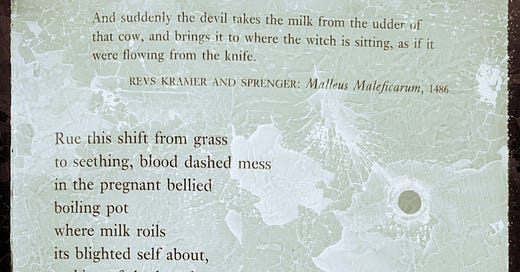Thank you for reading these posts, I realise there is a lot of content on Substack these days. I am looking back at some of the research I did for Constructing a Witch (Bloodaxe 2024), so search back on Substack if you’d like to see more.
If you have ever tried and failed to control the behaviour of milk while being a woman, then think back to the days when every aspect of dairying was the sole responsibility of women. Imagine yourself back to the witchcraft accusations of sixteenth and seventeenth centuries when the distribution of domestic chores meant that domestic chores such as dairying fell to women. It could be described as occupational hazard for a woman to be accused of witchcraft. Milk turns on a sixpence does it not? If you search online ‘How long can you leave milk out of the fridge for?’ the internet tells you: ‘Two hours’. At room temperature, bacteria starts to grow, milk sours, curdles - it becomes lumpy and definitely unsafe to drink. Now imagine a life without the safety of refrigeration when there are folk looking around for somebody to blame for sickness or some other ill.
Once, here in Norfolk in this day and age, we unwittingly left left a tiny bit of spilled milk on the hob of our tiny caravan for a few winter months. When we opened the door - the stench! One could have believed that the Devil had take a little sabbatical from his evil doings to put his cloven hooves up for a bit of time by the sea.
Many witchcraft accusations involved suspicious workings around milk. For example, Alice Gray in the Pendle Witch Trials suspected her neighbours when cheese began to “rise up in bunches like biles [boils] &… heave & wax bitter”. And blood in the milk which we now know would be caused by mastitis, would have been a horrifying spectacle. In a number of eighteenth-century Swedish church court prosecutions there are accusations that witches turned cows’ milk into blood.
It was thought that placing a horse shoe in the pan could purify milk. They were traditionally made from iron, which could ward away evil, and nailed into place by a lucky seven nails. Horse shoes are still considered lucky. Blacksmiths themselves were historically believed lucky and revered for their craft, as they worked with fire and iron, both seen as powerful and protective elements. The Blacksmith of course, being a traditionally male occupation.
In my poem, I have used one of the numerous quotes about milk in the Malleus Maleificarum, with that dangerous little juxtaposition of udder and knife. Here the narrator calls upon the smithy as counter-magic to the badness the woman is making of her domestic work with fire. Oh and it’s not just off milk - it’s the corruption of the very Hearth itself. In Anglo-Saxon culture, the hearth was central to daily life and spirituality. The fire within was more than a source of warmth or cooking - it represented a divine presence. As Christianity spread through Anglo-Saxon Britain, the hearth remained a hub and the heart of the home. The stories they told there were no longer of gods and monsters but saints, and divine victory over paganism. And the woman as keeper of that fire was responsible preventing the Devil (or the old gods) from creeping down the chimney and seething your milk.
(Please ‘like’ this post, if you do like it. I need the dopamine hit! )





I used to teach witchcraft as a historical phenomenon for a piece of A2 coursework. Your poem is very interesting. Thank you
These notes are really fascinating. More please!